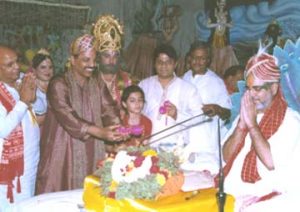The Ramayana teaches you how to live said Pujya Bhaishri during Ram Katha at Delhi, India
Pujya Bhaishri’s Ram Katha in Delhi was hosted by Shri Dharmik Sewa Samiti. The aim of this katha was just ‘Swatma Sukhartha’ i.e. for Self happiness. The katha began at 10 a.m. on 17th March 2006 with a grand Shobha yatra of the Ramayanji which started from the local Sri Ramkrishna temple. 108 women carrying the auspicious ‘Kalash’ accompanied the Pothiji in this yatra. After traversing through various streets and lanes of Delhi city the yatra reached the venue of the Katha where learned Brahmins welcomed the Ramayanaji and Pujya Bhaishri amidst Vedic chants. Pujya Bhaishri worshipped the deities and the aarti was performed.
After the welcome speeches the auspicious lamp was kindled. Thereafter the host family offered their worship to ‘Ramayanaji’ and Pujya Bhaishri.
In his inaugural speech Pujya Bhaishri said that Ramayana teaches us ‘How to live’ while Shrimad Bhagwat teaches us ‘How to die’. In childhood we should read Mahabharata, in our young age we should read Ramayana and in our old age we should read Bhagavat. Mahabharata teaches us what we should do and what we should not do. How we should live our life is taught by Ramayana. And, how should we live in the evening of our life? How to face death? That is taught by Shrimad Bhagavat. We must die in such a way that we may not have to die again and again. Give up attachments, be freed from all bonds and leave this world with a freed mind so that you are liberated permanently, so that you may not have to be trapped again in the womb of another woman. And you may not have to die again to be reborn again. Die in such a way that you are freed from this cycle of birth, death and re-birth forever.
There are more than a hundred billion Ramayanas. ‘Ramayana shatkoti apaaraa.’ But ‘Sri Ramacharitmanas’ of Tulasidasji is a unique scripture. Its chaupais, verses are sung even by the rural folks. By composing it in the common man’s language Tulasidasji has made it easily accessible and easily comprehensible for everyone. Lord Ram’s name is even more beneficent than Lord Ram himself. We should chant Lord Ram’s name with whatever feeling or attitude. Even if it is chanted wrongly or in the reverse, Ram’s name liberates us from the attachment to the lures of this world. Therefore we should chant it at all times. Be it while sitting in a place or while moving around or even in sleep we must keep chanting His name.
The occasion of Ram janma was celebrated with great joy and fervour at 8 p.m. The Ashoka vihar area of Delhi city was transformed into Ayodhya, the venue of Shri Ram’s vihar. Prasad of panjari was distributed to all thereafter.
During the katha, Pujya Bhaishri also discussed many modern issues like non-vegetarianism The flesh, muscles, tissues, minerals, fluids, etc. all are formed in our body from the food that we eat. And what do the non-vegetarian people do? They eat the same flesh again which has been already formed from grains and vegetables. Hence they become victims of diseases like bird flu. And because of this thousands of chickens are killed. All animals of the world are divided into two categories. Carnivorous and herbivorous. What is the difference between the two? The carnivorous animals drink water with their tongue while the herbivorous animals like humans drink water with their lips. It is a simple principle. You cannot run a petrol engine vehicle on diesel. Giving various such examples Pujya Bhaishri debated why humans are fit only for vegetarian food and that we must refrain from eating non-vegetarian food.
Pujya Bhaishri elucidated various stories from the Ramayana leaving people enchanted by his unique style of narrating kathas and singing the chaupais of the Manas in Inidan classical style.
Delhi Ram Katha concluded in a devotional and affectionate ambience.
